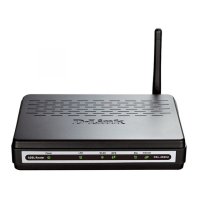Web Configuration
D-Link DSL-2600U User Manual
62
Wireless Security
Various security options are available on the Modem including open or WEP, 802.1x, WPA, WPA-PSK, WPA2 and WPA2-PSK. Authentication may use an open system or
a shared key. For details on these methods and how to use them, please read the wireless LAN configuration information in Section 3.5.3 (Wireless Security
Configuration).
About 802.11g Wireless
802.11b is an IEEE standard, operating at 2,4 GHz at a speed of up to 11 Mb/s. 802.11g, a newer IEEE standard also operating at 2,4 GHz, gives you up to 54 Mb/s speed,
more security and better performance.
Today's 11-megabits-per-second 802.11b wireless networks are fine for broadband Internet access (which typically tops out at about 1 mbps) but rather slow for large
internal file transfers or streaming video. However, 54-mbps, corporate-oriented 802.11a is expensive and because its radio uses the 5-GHz band and 802.11b uses the
2.4 GHz band, upgrading to an 802.11a network means either scrapping 802.11b gear or buying even-pricier hardware that can support both standards.
But 802.11g promises the same speed as 802.11a and the ability to coexist with 802.11b equipment on one network, since it too uses the 2.4-GHz band. 802.11g is an
extension to 802.11b, the basis of many wireless LANs in existence today. 802.11g will broaden 802.11b's data rates to 54 Mbps within the 2.4 GHz band using OFDM
(orthogonal frequency division multiplexing) technology. Because of backward compatibility, an 802.11b radio card will interface directly with an 802.11g access point (and
vice versa) at 11 Mbps or lower depending on range. You should be able to upgrade the newer 802.11b access points to be 802.11g compliant via relatively easy firmware
upgrades.
Similar to 802.11b, 802.11g operates in the 2.4GHz band, and the transmitted signal uses approximately 30MHz, which is one third of the band. This limits the number of
non-overlapping 802.11g access points to three, which is the same as 802.11b.
Note: Maximum wireless signal rate based on IEEE Standard 802.11g specifications is 54 Mbps. But actual data throughput varies depending on network conditions and
environmental factors, including volume of network traffic, building materials and construction, and network overhead will cause lower actual data throughput rate.
Access Point and Wireless Fidel
The Wi-Fi certification ensures that your Modem will interoperate with any Wi-Fi certified 802.11g and 802.11b compliant wireless device.
The Modem Wireless LAN Access Point (AP) behaves as a networking hub allowing to wirelessly interconnect several devices to the local (W) LAN and to provide access
to the Internet.
Wireless – Basic
This page allows you to configure basic features of the wireless LAN interface. You can enable or disable the wireless LAN interface, hide the network from active scans,
set the wireless network name (also known as SSID) and restrict the channel set based on country requirements.

